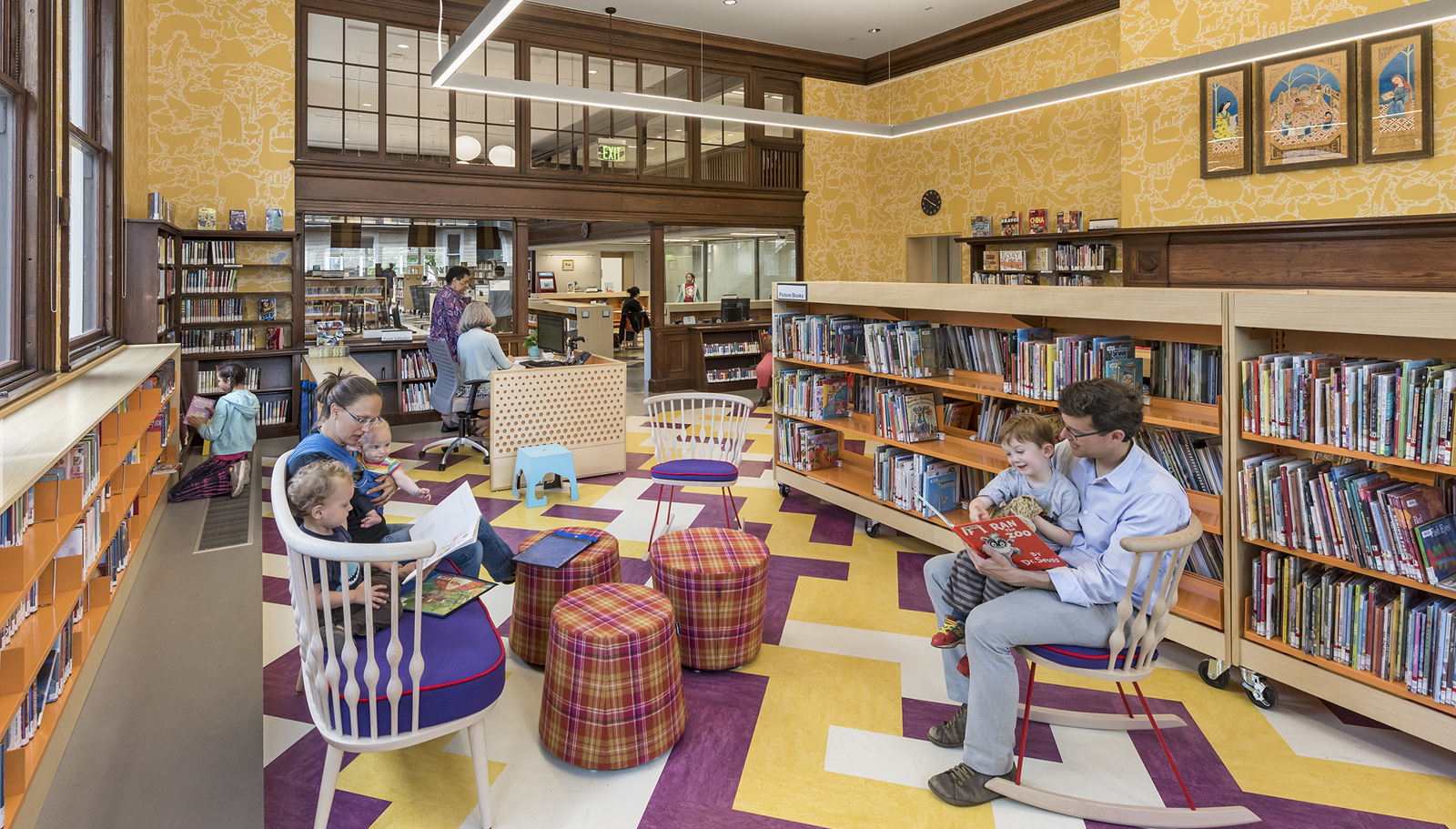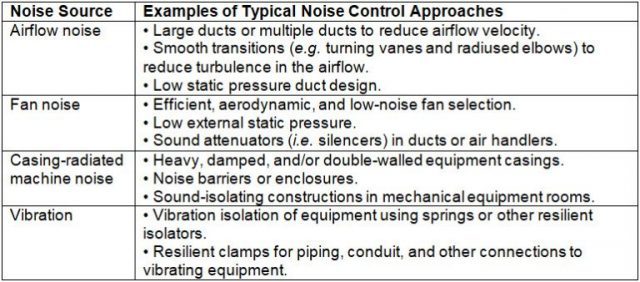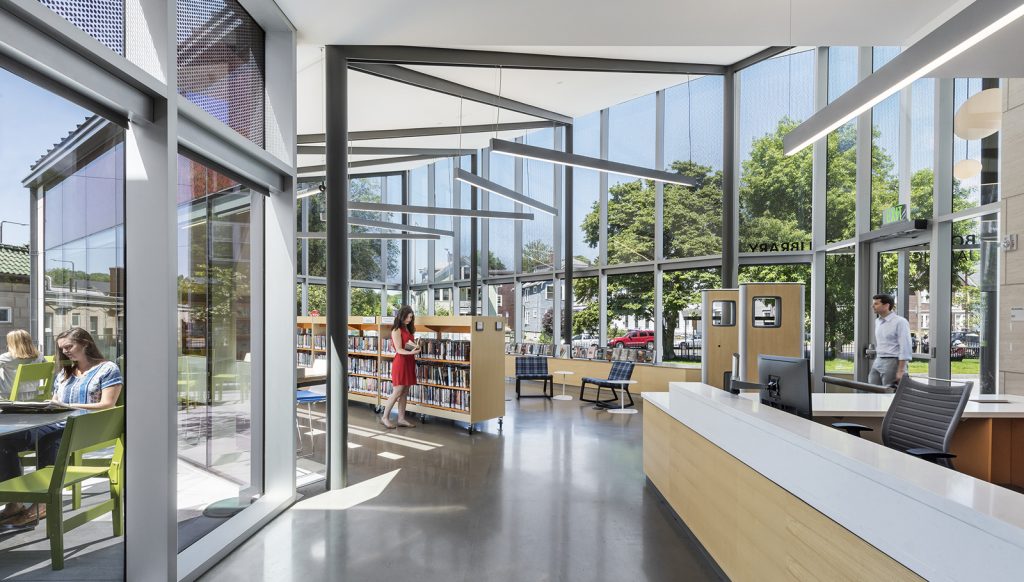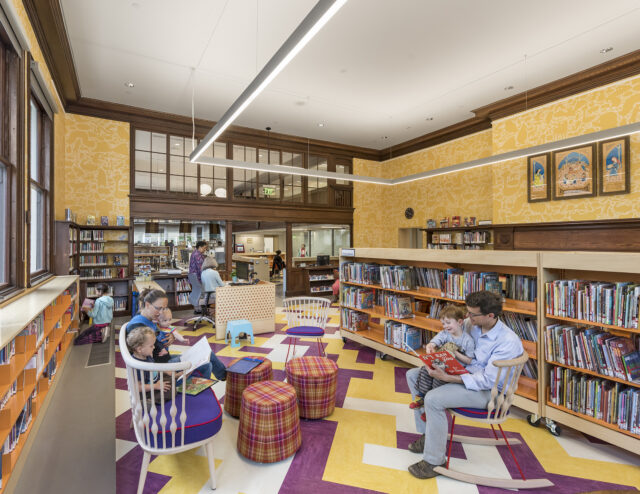Benjamin Markham
President

It is intuitive the acoustical environment plays a key role in the wellness, education, and productivity of building occupants. After all, mankind only has the benefit of eyelids, and not “earlids;” one can avert the gaze, but not hearing. Sound is all around, and the acoustical environment impacts everyone, whether consciously or not.
How many times do guests wake up in a hotel room because of the TV next door, the traffic outside, or the door slamming down the hall?
In the workplace, research on productivity and “deep work” demonstrates the benefits of distraction-free environments, just as economic realities are forcing ever-greater density in office spaces. In hospitals, the healing benefits of rest and sleep are increasingly recognized in building design. Control over extraneous noise is a key component of current healthcare design guidelines. In the classroom, low noise and high speech intelligibility lead to greater learning outcomes.
Building design standards, such as the General Services Administration’s (GSA’s) P-100, Facilities Standards, and Facility Guidelines Institute’s (FGI’s) healthcare design guideline recognize the necessity of good acoustical design. Acoustics-related credits are also offered by sustainability scorecards from the Leadership in Energy and Environmental Design (LEED), WELL, and Collaborative for High Performance Schools (CHPS) programs.
With good design and thoughtful planning, building acoustics can work very much to one’s advantage, enabling communication across the classroom, collaboration in the lab, privacy in the workplace, and a good night’s sleep. What matters acoustically is not (just) how loud something is but how loud that something is relative to the background sound. If high speech intelligibility is the goal, one must design for a high signal-to-noise ratio, meaning the speech (signal) should be nice and loud in comparison to the background sound (noise), which should be kept quiet. By contrast, if the design goal is speech privacy (e.g. confidentiality between patient rooms or law offices), the signal-to-noise ratio should be low—the loudness of speech coming from “next door” (signal) should be kept quiet, relative to the background sound in the observer’s room.
Good acoustical design intentionally crafts the architectural environment and the building systems to optimize the signal-to-noise ratio based on the programmed uses, rather than leaving acoustical character to happenstance.
There are three main areas of architectural acoustics design:
A fourth area—sound system design—is related and can be important for many spaces, whereas the first three—the focus of this article—are worth careful consideration in nearly all architectural environments.
The first step toward achieving the proper signal-to-noise ratio in a space is to control the background noise. This starts with setting a goal. Background noise goals are most typically specified in terms of noise criteria (NC) ratings. These ratings are based on curves standardized in the American National Standards Institute/Acoustical Society of America (ANSI/ASA) S12.2-2008, Criteria for Evaluating Room Noise. This standard, as well as a range of other industry guidelines, provides recommendations for background sound levels based on use.
For example, in concert halls and theaters, background sound levels must be extremely low (in some cases, levels as low as the threshold of human hearing are recommended). In a classroom or lecture space, NC 25 to 30 (or, equivalently, 35 dBA as required by ANSI S12.60, Acoustical Performance Criteria, Design Requirements and Guidelines for Schools) is a typical goal for maximum sound levels. In offices, NC 40 is typical and usually appropriate—if it is quieter, occupants might get distracted by surrounding activity.
In a lab with fume hoods and high air-change requirements, NC 45 may be about as quiet as is practical or necessary for communication across fairly short distances such as across the bench.
Once an appropriate goal is established, noise control measures must be designed so building systems, predominately HVAC systems, meet the target. The four most prominent noise sources in a building are:

Figure 1 shows some typical noise control approaches. (For more, click here.)
Of course, background noise is not always bad. In fact, in spaces where one wishes to boost privacy (e.g. offices, libraries, and healthcare facilities), it can be appropriate to increase the background sound level judiciously. This can be accomplished effectively with an electronic sound masking system.
Building system noise within a space is not the only type of noise that might distract, annoy, disturb, or otherwise inhibit our enjoyment, wellness, and productivity. Noise in adjacent spaces—whether inside or out—must also be controlled appropriately. When addressing such concerns, there are three basic elements the design team can consider:
Controlling noise at the source is often effective, but the approach may be insufficient or unavailable. Making changes to the receiver environment by adding sound masking or wearing earplugs may likewise be unavailable, insufficient, or impractical.
Sound isolation concerns the path from source to receiver—how sound is blocked or transmitted from one space to another. Partitions, floor/ceiling assemblies, windows, doors, and other building elements can be constructed in order to block the transmission of sound. Here again, one starts with the goal of determining how well-isolated a space needs to be. For a performance space, isolation is critically important. For a classroom, sound isolation is necessary for distraction-free learning, but the stakes are not as high as in a world-class concert hall. However, for an innovation center, overhearing conversations in adjacent areas may be part of the intended experience to spur collaboration between groups or across disciplines.
In the United States, interior-to-interior sound isolation is most typically evaluated in terms of sound transmission class (STC) ratings. For building façades, the outdoor-indoor transmission class (OITC) rating is employed. To evaluate impact sound isolation of a floor/ceiling assembly (for example, from footfall noise), one must employ the impact isolation class (IIC) rating. These and other sound isolation metrics are defined by ASTM standards. (Note: STC and OITC are classified in ASTM E413, Classification for Rating Sound Insulation. The measurement standard for STC is ASTM E90, Standard Test Method for Laboratory Measurement of Airborne Sound Transmission Loss of Building Partitions and Elements. IIC is classified in ASTM E989, Standard Classification for Determination of Impact Insulation Class [IIC], and the measurement standard is ASTM E492, Standard Test Method for Laboratory Measurement of Impact Sound Transmission through Floor-ceiling Assemblies Using the Tapping Machine.)
When designing sound-isolating assemblies, designers have the following tools at their disposal.
The heavier the construction, the more sound it will block. For example, a partition with two layers of gypsum wallboard (GWB) on each side will block 6 dB more sound at most mid-frequencies than the same partition with just one layer of GWB on each side.
Two masses are far better than one at blocking noise. For example, double-stud partitions outperform single-stud walls of equal mass, and floor/ceiling assemblies (where the ceiling is resiliently decoupled from the floor) will block far more sound (both airborne and impact) than a monolithic construction of equal mass. To illustrate the point, take the case of a steel-framed building with a 159-mm (6 ¼-in.) total depth composite lightweight concrete/metal deck floor slab and a wire-suspended GWB ceiling. This construction consistently performs around STC 60 (depending on details such as the depth of the ceiling plenum). A 203-mm (8-in.) thick cast-in-place concrete slab of normal weight concrete (NWC) weighs substantially more, but does not block more sound—it achieves STC 58.
Insulation or another sound-absorbing material between two masses (e.g. inside the cavity of a stud partition or between the ceiling and the underside of the structural deck) can significantly improve the isolation performance of the overall assembly. Exact results vary depending on the specific assembly, but for example, a stud wall with one layer of GWB performs roughly six STC points better when the stud cavity is insulated with a lightweight unfaced fiberglass batt than it does uninsulated.
Specifying a damping material as a component of a building product (e.g. lamination in a glass window) can improve sound isolation at certain frequencies. For example, a 25-mm (1-in.) insulated glazing unit (IGU) with a laminated lite performs around STC 39, while a typical IGU with standard tempered glass performs around STC 35 (results vary depending on frame details).
Once the building constructions are designed, it is also critical to address any gaps, cracks, weaknesses, flanking paths (i.e.paths for sound transmission circumventing a wall, or the floor/ceiling assembly) denigrating the sound isolation performance. An outstanding wall can be close to useless if sound is able to travel around it. Common examples of flanking paths include:
If any of these flanking paths exist, sound will “leak” through them, such that no matter how great the partition may be, sound from the adjacent space will still be heard.
The way a room sounds—whether it is reverberant or “dry”—is defined by the room’s size, shape, and distribution of sound-absorbing, reflecting, and scattering surfaces. The larger a room is, the more reverberant it tends to be. Conversely, the more sound-absorbing materials there are in a room, the less reverberant it will be. Materials absorbing sound tend to be rather different than materials blocking sound transmission. The former are usually lightweight, porous materials like fibrous or open-cell insulation, while the latter tend to be heavy. The key is absorbing and blocking sound are not the same. The proverbial “concrete bunker” is excellent at blocking sounds—one can have a very private conversation inside a bunker but the material is highly reflective and not absorptive. Therefore, it is very reverberant inside a concrete bunker.
A material’s absorptivity and reflectivity can be specified in terms of its sound absorption coefficients. These coefficients range from 0 (totally reflective) to 1 (totally absorptive). They vary with frequency; a mid-frequency average absorption coefficient (useful for speech) is called the noise reduction coefficient (NRC). When specifying sound-absorbing materials (e.g. fabric-wrapped panels, acoustic ceiling tiles [ACTs], or perforated wood or metal systems) in a building, it is important the absorption requirements be clearly defined. For a space where speech is the primary sound source (e.g. an office), the NRC may be sufficient; in other rooms, minimum (or maximum) absorption coefficients across the audible frequency range may need to be specified. Since materials absorb a different fraction of incident sound depending on how they are mounted, it is important the absorptivity be specified for the mounting condition utilized on the project. For example, ACT absorbs far more when suspended in a grid below the deck (in which case, absorption using the E-400 mounting should be specified, where the tile is held 400 mm [16 in.] from the substrate) than it does when surface-applied to the deck (where absorption with a type A mounting should be specified).
In real buildings, all of these concepts—noise control, sound absorption, and sound isolation—come together.

To meet the Boston library’s acoustical and aesthetic needs a system with a fiberglass sound-absorbing core and a smooth, white, sound-transparent fabric stretching over it was employed.
The Jamaica Plain branch of the Boston Public Library, designed by architectural firm Utile, is a good example. In a new building addition, there was interest in integrating a smooth white finish that could also provide sound absorption, which was accomplished with a stretch fabric. Acoustical consultants recommended a ceiling with an NRC value of 0.80 or greater, to control the reverberant build-up of noise in the space. Designers at Utile had a smooth, monolithic, white appearance in mind. Together, they identified a system with a fiberglass sound-absorbing core and a smooth, white, sound-transparent fabric stretched over it that met both the project’s acoustical and aesthetic needs.

A gypsum board ceiling suspended on resilient clips with sound-absorbing batt insulation in the ceiling plenum was employed to achieve sound isolation at the Children’s Reading Room at The Jamaica Plain branch of the Boston Public Library, Massachusetts.
The Children’s Reading Room required special acoustical attention. Since its location is directly below a staff-community meeting room, additional sound isolation at the floor/ceiling assembly was required to ensure rumpus time and storytelling sessions would not interfere with important discussions happening above. This was accomplished with a gypsum board ceiling suspended on resilient clips, along with sound-absorbing batt insulation in the ceiling plenum.
More efficient ventilation systems and mechanical noise control were needed within the building as well, which, in turn, reduced the library’s community noise impact within a bustling Boston neighborhood. Acoustical consultants modeled noise levels of exterior equipment to determine the potential impact relative to the City of Boston’s noise regulations, and also measured sound levels in the area prior to the renovation project to establish a benchmark for future assessment. The consultants then worked with the design team to meet those regulations with a combination of quiet equipment selection and strategic equipment location.
What does an NC 35 room sound like? Will an STC 50 wall be good enough? How reverberant is too reverberant for a music room? How dry is too dry for a lecture hall?
These are altogether reasonable questions, and point to a key aspect of building acoustics: subjectivity. Background noise, sound isolation, and room acoustics characteristics can be quantified and described, but the quantities are imperfect and the descriptions can fall short of truly evoking the sonic experience. When making decisions about the acoustical ramifications of design decisions, sometimes there is no substitute for actually hearing the difference.
Mock-up constructions can be an outstanding way to make these kinds of comparisons, but they are often impractical or cost-prohibitive, and some design decisions (how high should the ceiling be?) do no usually lend themselves to a mock-up. Enter auralization—the acoustical equivalent of visualization and the process of rendering the sound of a space (for one’s ears and not eyes) based on a model of the area. Designers and users can get a sense of the space as well as experience how design decisions change acoustical and visual aspects of the room before it is built.
To be most effective, an auralization should be 3D—it should give the listener a sense of depth, where the sound is coming from, and the size of a space.
The Olin School of Business, designed by Moore Ruble Yudell Architects, on the campus of Washington University in St. Louis, Missouri, features a sweeping central atrium with a sunken forum. The acoustical goals were to support an engrossing lecture in the forum, while the bustle of the glass-enclosed atrium (complete with café) soars above and around it. A 3D listening simulation was employed for the architects and Olin School administrators and facility staff to get a sense of how much sound-absorbing material would be needed in the atrium to control the bustle, to evaluate how the sound system would or would not overcome the bustle (and how the reverberance of the atrium would affect the quality of the sound system), and to predict whether faculty—whose office windows overlook the atrium—might be bothered by all the bustle.
The building owners and design team had a chance to listen to a simulation of a lecture in the forum (presented by a member of the Olin School faculty, no less), allowing them to compare various design scenarios: with and without sound-absorbing perforated wood wall panels in the atrium. Further, the intended lecture could be presented amplified or unamplified, during a simulated normal morning or busy lunch hour, and from several vantage points throughout the room. In addition to comparisons among room acoustics designs, listeners could also hear differences between different sound-isolating constructions: the activity in the atrium and forum could be observed from within a faculty office overlooking the space, with various glazing profiles in place (e.g. single-pane window and dual-pane IGU).

The simulation helped the team make design decisions regarding what materials to employ in the atrium, how much sound-absorbing material to utilize, and what kind of windows to install in faculty offices. In the end, the atrium features a plaster-like troweled sound-absorbing finish on the lower-level ceiling near the forum, micro-perforated wood panels on the walls, and other materials carefully integrated with the interior design. For the interior glazing, the simulation helped the design team and owners determine fairly standard single-pane windows would be sufficient for the faculty offices, saving the project the cost of double-pane glazing (although sufficient sill depth was left in the design to accept a future interior storm window, should more attenuation be deemed necessary at a later date).
A screen grab of the 3D listening simulation employed at The Olin School of Business to determine the most effective sonic design.

To develop such simulations, a 3D computer model of the space is generated, and the surfaces of the model are “painted” not with color but with the acoustical properties of the materials: sound-absorption, scattering, or transmission. A sound source is then placed inside the model, and a computer program simulates how sound propagates and reverberates in the room and, ultimately, arrives at a listener location. The output of this model can be compared directly with measurements made in the completed room later—a process helping acousticians refine their models and modeling skills over time. The same output, called an impulse response, can be combined with specially recorded audio to create a simulation. The result is then played back to the listener with a specialized audio playback system designed to preserve the level, timing, and directionality of sound reflections in the simulated space, and is linked with a visual display to orient the listener. All three design concepts described earlier—background sound, sound isolation, and room acoustics—can be simulated, thereby creating a powerful tool for designers and users to make comparisons and develop a sense of how design choices affect the aural experience.
Micro-perforated wood panels around the windows provide critical sound absorption for the atrium at the Olin School of Business located on the campus of Washington University in St. Louis, Missouri.
Acoustics matter and sonic design should not be an accident. When the planning, design, and specification process has the benefit of a robust understanding of acoustical design principles—particularly when it can be supplemented by an acoustical simulation—the design, engineering, and construction team can be intentional about creating the acoustical quality that will benefit the education, wellness, and productivity of the building occupants.
Ben Markham, LEED AP, is director of Acentech’s architectural acoustics group. He consults on projects involving architectural acoustics, mechanical systems noise and vibration control, and environmental acoustics in commercial, residential, and civic facilities. Markham has an avid interest in acoustical models. He is a member of the Acoustical Society of America (ASA) and was awarded the Robert B. Newman Medal for Architectural Acoustics in 2002. Markham can be reached via e-mail at bmarkham@acentech.com.